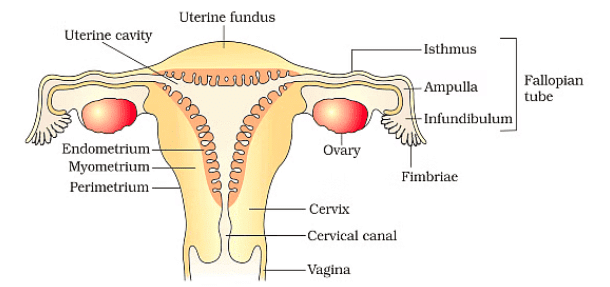Important Diagrams: Human Reproduction | Biology Class 12 - NEET PDF Download
Humans are sexually reproducing and viviparous. The reproductive events in humans include formation of gametes (gametogenesis), transfer of sperms into the female genital tract (insemination) and fusion of male and female gametes (fertilisation) leading to formation of zygote. This is followed by formation and development of blastocyst and its attachment to the uterine wall (implantation), embryonic development (gestation) and delivery of the baby (parturition). Based on these events, some important diagrams for NEET Examination are given below.
1. Male Pelvis
- The male reproductive system is located in the pelvis region. It includes a pair of testes alongwith accessory ducts, glands and the external genitalia.
- The testes are situated outside the abdominal cavity within a pouch called scrotum.
- The scrotum helps in maintaining the low temperature of the testes (2- 2.5oC lower than the normal internal body temperature) necessary for spermatogenesis.
- In adults, each testis is oval in shape, with a length of about 4 to 5 cm and a width of about 2 to 3cm.
- Each testis has about 250 compartments called testicular lobules.
 Structure of Male Pelvis
Structure of Male Pelvis
2. Male Reproductive System
- The male sex accessory ducts include rete testis, vasa efferentia, epididymis and vas deferens.
- The seminiferous tubules of the testis open into the vasa efferentia through rete testis.
- The vasa efferentia leave the testis and open into epididymis located along the posterior surface of each testis.
- The urethra originates from the urinary bladder and extends through the penis to its external opening called urethral meatus.
- The penis is the male external genitalia.
- The enlarged end of penis called the glans penis is covered by a loose fold of skin called foreskin.
 Male Reproductive System
Male Reproductive System
3. Seminiferous Tubule
- Each testicular lobule contains one 1-3 highly coiled seminiferous tubules in which sperms are produced.
- Each seminiferous tubule is lined on its inside by two types of cells called male germ cells (spermatogonia) and Sertoli cells.
- The male germ cells undergo meiotic divisions finally leading to sperm formation.
- Sertoli cells provide nutrition to the germ cells.
- The regions outside the seminiferous tubules called interstitial spaces, contain small blood vessels and interstitial cells or Leydig cells.
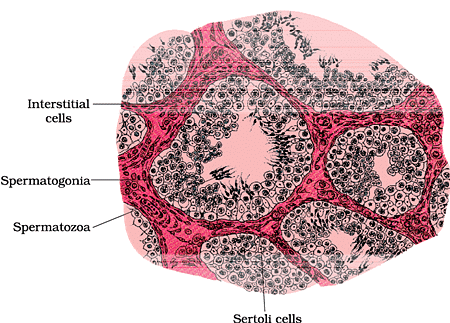 Sectional View of Seminiferous Tubule
Sectional View of Seminiferous Tubule
4. Female Reproductive System
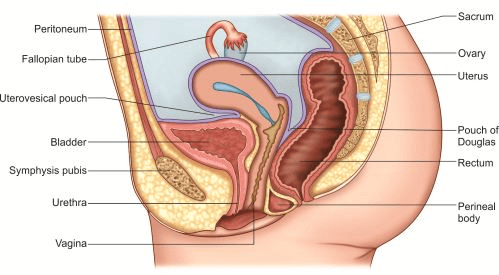 Diagrammatic sectional view of female pelvis showing reproductive system The female reproductive system consists of a pair of ovaries along with a pair of oviducts, uterus, cervix, vagina and the external genitalia located in pelvic region.
Diagrammatic sectional view of female pelvis showing reproductive system The female reproductive system consists of a pair of ovaries along with a pair of oviducts, uterus, cervix, vagina and the external genitalia located in pelvic region.
- The oviducts (fallopian tubes), uterus and vagina constitute the female accessory ducts.
- The part closer to the ovary is the funnel-shaped infundibulum.
- The edges of the infundibulum possess finger-like projections called fimbriae, which help in collection of the ovum after ovulation.
- The infundibulum leads to a wider part of the oviduct called ampulla.
- The last part of the oviduct, isthmus has a narrow lumen and it joins the uterus.
- The cavity of the cervix is called cervical canal which along with vagina forms the birth canal.
- The wall of the uterus has three layers of tissue: The external thin membranous perimetrium, middle thick layer of smooth muscle (myometrium) and inner glandular layer (endometrium) that lines the uterine cavity.
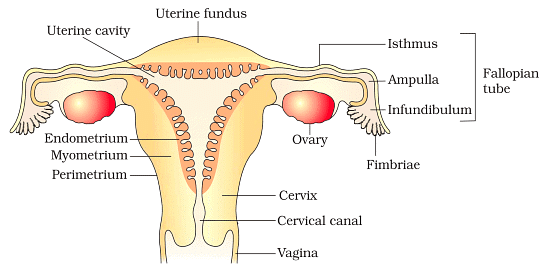 Female Reproductive System
Female Reproductive System
5. Mammary Glands
- A functional mammary gland is characteristic of all female mammals.
- The glandular tissue of each breast is divided into 15-20 mammary lobes containing clusters of cells called alveoli.
- The cells of alveoli secrete milk, which is stored in the cavities (lumens) of alveoli.
- The alveoli open into mammary tubules.
- The tubules of each lobe join to form a mammary duct.
- Several mammary ducts join to form a wider mammary ampulla which is connected to lactiferous duct through which milk is sucked out.
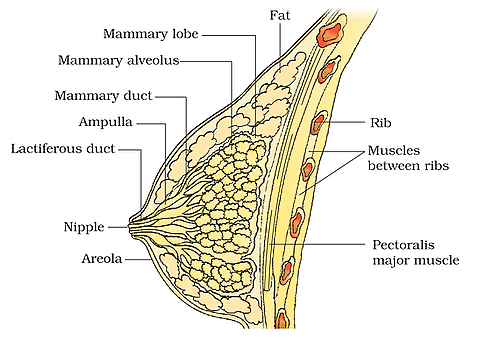 Mammary Glands
Mammary Glands
6. Gametogenesis
- Each spermatogonium is diploid and contains 46 chromosomes.
- Some of the spermatogonia called primary spermatocytes periodically undergo meiosis.
- A primary spermatocyte completes the first meiotic division (reduction division) leading to formation of two equal, haploid cells called secondary spermatocytes, which have only 23 chromosomes each.
- The secondary spermatocytes undergo the second meiotic division to produce four equal, haploid spermatids.
- The spermatids are transformed into spermatozoa (sperms) by the process called spermiogenesis.
- After spermiogenesis, sperm heads become embedded in the Sertoli cells, and are finally released from the seminiferous tubules by the process called spermiation.
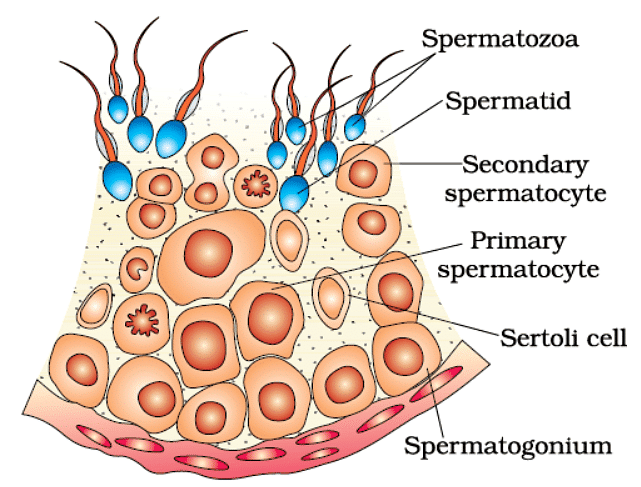 Seminiferous Tubule depicting Spermatogenesis
Seminiferous Tubule depicting Spermatogenesis
7. Structure of a Sperm
- It is a microscopic structure composed of a head, neck, a middle piece and a tail.
- A plasma membrane envelops the whole body of sperm.
- The sperm head contains an elongated haploid nucleus, the anterior portion of which is covered by a cap-like structure, acrosome.
- The acrosome is filled with enzymes that help fertilisation of the ovum.
- The middle piece possesses numerous mitochondria, which produce energy for the movement of tail that facilitate sperm motility essential for fertilisation.
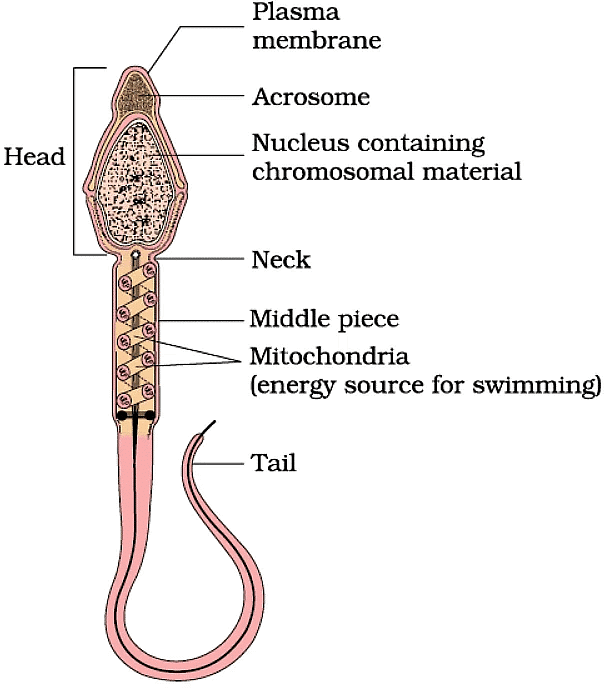 Structure of a Sperm
Structure of a Sperm
8. Sectional View of an Ovary
- Oogenesis is initiated during the embryonic development stage, no more oogonia are formed and added after birth.
- These cells start division and enter into prophase-I of the meiotic division called primary oocytes.
- Each primary oocyte then gets surrounded by a layer of granulosa cells and is called the primary follicle. The primary follicles get surrounded by more layers of granulosa cells and a new theca and are called secondary follicles.
- The secondary follicle soon transforms into a tertiary follicle which is characterised by a fluid filled cavity called antrum.
- The tertiary follicle further changes into the mature follicle or Graafian follicle.
- The Graafian follicle now ruptures to release the secondary oocyte (ovum) from the ovary by the process called ovulation.
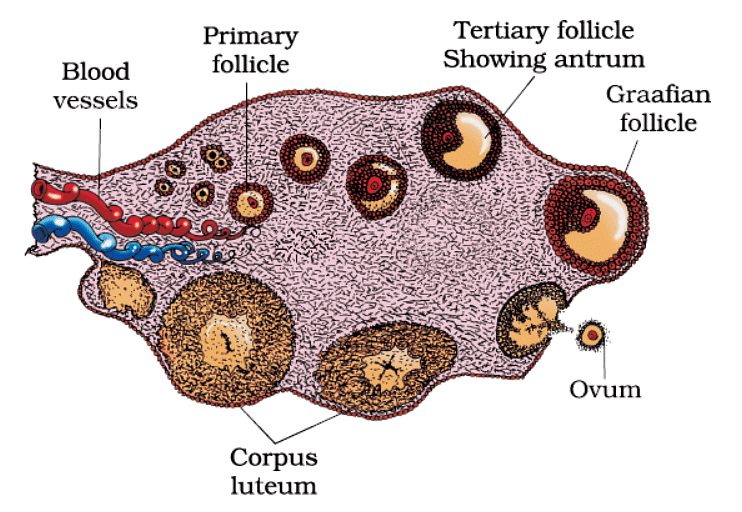 Sectional View of an Ovary
Sectional View of an Ovary
9. Spermatogenesis
- Spermatogenesis is the process of the production of sperms from the immature germ cells in males.
- During spermatogenesis, a diploid spermatogonium (male germ cell) increases its size to form a diploid primary spermatocyte.
- This diploid primary spermatocyte undergoes first meiotic division (meiosis I), which is a reductional division to form two equal haploid secondary spermatocytes.
- Each secondary spermatocyte then undergoes second meiotic division (meiosis II) to form two equal haploid spermatids.
- Hence, a diploid spermatogonium produces four haploid spermatids.
- These spermatids are transformed into spermatozoa (sperm) by the process called spermiogenesis.
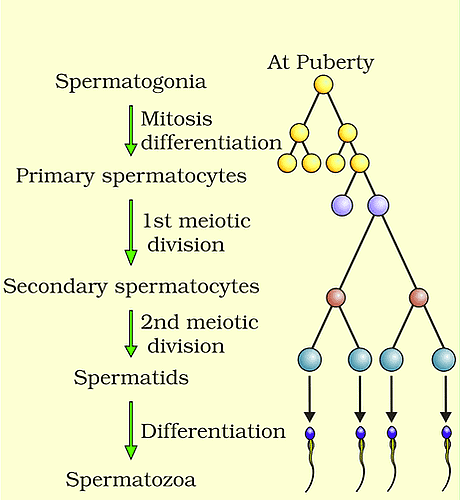 Spermatogenesis
Spermatogenesis
10. Oogenesis
- Oogenesis is the process of the formation of a mature ovum from the oogonia in females. It takes place in the ovaries.
- During oogenesis, a diploid oogonium or egg mother cell increases in size and gets transformed into a diploid primary oocyte.
- This diploid primary oocyte undergoes first meiotic division i.e., meiosis I or reductional division to form two unequal haploid cells. The smaller cell is known as the first polar body, while the larger cell is known as the secondary oocyte.
- This secondary oocyte undergoes second meiotic division i.e., meiosis II or equational division and gives rise to a second polar body and an ovum.
- Hence, in the process of oogenesis, a diploid oogonium produces a single haploid ovum while two or three polar bodies are produced.
 Oogenesis
Oogenesis11. Menstrual Cycle
- One ovum is released (ovulation) during the middle of each menstrual cycle.
- The cycle starts with the menstrual phase, when menstrual flow occurs and it lasts for 3-5 days.
- The menstrual phase is followed by the follicular phase. During this phase, the primary follicles in the ovary grow to become a fully mature Graafian follicle and simultaneously the endometrium of uterus regenerates through proliferation.
- The secretion of gonadotropins (LH and FSH) increases gradually during the follicular phase, and stimulates follicular development as well as secretion of estrogens by the growing follicles.
- Both LH and FSH attain a peak level in the middle of cycle (about 14th day). Rapid secretion of LH leading to its maximum level during the mid-cycle called LH surge induces rupture of Graafian follicle and thereby the release of ovum (ovulation).
- The ovulation (ovulatory phase) is followed by the luteal phase during which the remaining parts of the Graafian follicle transform as the corpus luteum.
- The corpus luteum secretes large amounts of progesterone which is essential for maintenance of the endometrium.
 Various Events of Menstrual Cycle
Various Events of Menstrual Cycle
12. Fertilisation
- The process of fusion of a sperm with an ovum is called fertilisation.
- During fertilisation, a sperm comes in contact with the zona pellucida layer of the ovum and induces changes in the membrane that block the entry of additional sperms, ensuring that only one sperm can fertilise an ovum.
- The secretions of the acrosome help the sperm enter into the cytoplasm of the ovum through the zona pellucida and the plasma membrane.
- This induces the completion of the meiotic division of the secondary oocyte.
- The second meiotic division is also unequal and results in the formation of a second polar body and a haploid ovum (ootid).
- Soon the haploid nucleus of the sperms and that of the ovum fuse together to form a diploid zygote.
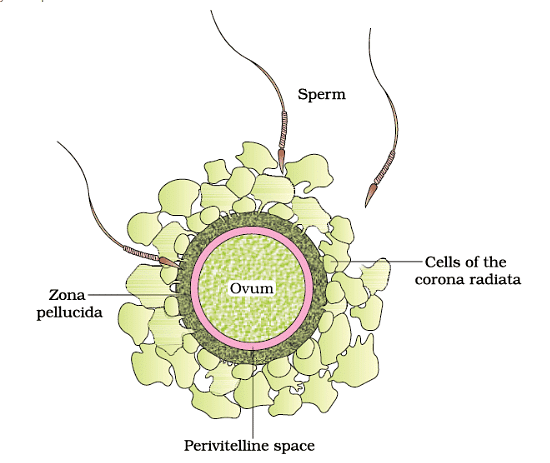 Ovum Surrounded by Sperms before Fertilisation
Ovum Surrounded by Sperms before Fertilisation
13. Different Stages of Growth of an Embryo
- The mitotic division of zygote (cleavage) starts and forms 2, 4, 8, 16 daughter cells called blastomeres.
- The embryo with 8 to 16 blastomeres is called a morula.
- The morula continues to divide and transforms into blastocyst as it moves further into the uterus.
- The blastomeres in the blastocyst are arranged into an outer layer called trophoblast and an inner group of cells attached to trophoblast called the inner cell mass.
- The trophoblast layer then gets attached to the endometrium and the inner cell mass gets differentiated as the embryo.
- After implantation, the uterine cells divide rapidly and covers the blastocyst. As a result, the blastocyst becomes embedded in the endometrium of the uterus leading to pregnancy.
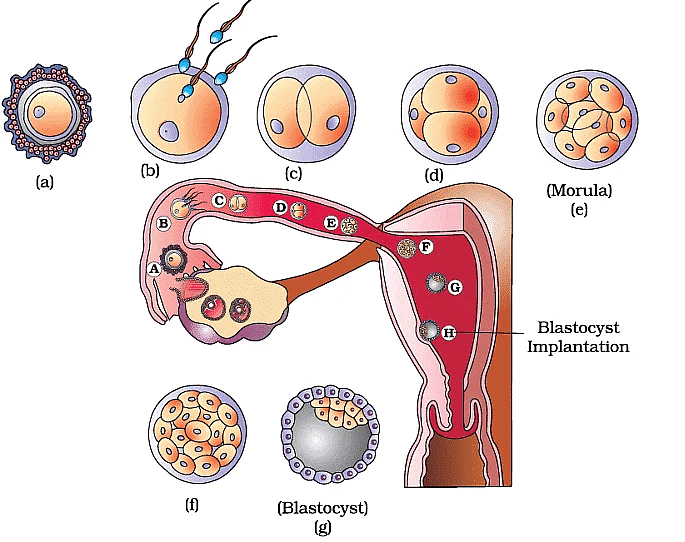 Fertilisation and Passage of Growing Embryo in Fallopian Tube
Fertilisation and Passage of Growing Embryo in Fallopian Tube
14. Pregnancy and Embryonic Development
After implantation, finger-like chorionic villi emerge from the trophoblast, intermingling with uterine tissue to form the placenta, which supplies nutrients and oxygen, removes waste, and produces essential hormones like hCG and hPL. The placenta connects to the embryo via the umbilical cord, facilitating transport and hormonal support for fetal development and maternal physiological adjustments throughout pregnancy.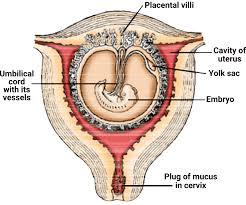 The human foetus within the uterus
The human foetus within the uterus
Diagram Based Previous Year Questions - NEET
Q1: Which of the following is not a component of Fallopian tube? [NEET 2024]
A. Uterine fundus
B. Isthmus
C. Infundibulum
D. Ampulla
Choose the correct answer from the options given below. (NEET 2024)
(a) A, B, C, and D only
(b) A, C, D, and E only
(c) C, D, and E only
(d) B, C, D, and E only
Ans: (a)
Sol: The Fallopian tubes, also known as oviducts or uterine tubes, are structures in the female reproductive system that stretch from the uterus to the ovaries. These tubes play a crucial role in the journey of the egg from the ovary to the uterus. The primary components of the Fallopian tubes include the infundibulum, ampulla, and isthmus:
When examining the options provided, Option A mentions the "Uterine fundus". The fundus is actually the top part of the uterus, situated above the openings of the Fallopian tubes into the uterine cavity. The fundus of the uterus is not a part of the Fallopian tubes; instead, it is a region of the uterus itself. Therefore, the correct answer is: Option A: Uterine fundus
Q2: Given below are two statements: [NEET 2022]
Statement I: The release of sperms into the seminiferous tubules is called spermiation.
Statement II: Spermiogenesis is the process of formation of sperms from spermatogonia.
In the light of the above statements, choose the most appropriate answer from the options given below :
(a) Statement I is correct but Statement II is incorrect
(b) Statement I is incorrect but Statement II is correct
(c) Both Statement I and Statement II are correct
(d) Both Statement I and Statement II are incorrect
Ans. (a)
Schematic Representation of Spermatogenesis
Solution.
- The process of spermatogenesis occurs in testis, in which the immature male germ cells or spermatogonia are converted to sperms.
- The spermatogonia present on the inside wall of seminiferous tubules undergoes mitosis.
- Some spermatogonia periodically undergo meiosis.
- These spermatogonia are called as primary spermatocytes (2n).
- A primary spermatocyte completes the first meiotic division and forms secondary spermatocytes (n). The secondary spermatocytes undergo the second meiotic division to produce spermatids.
- The spermatids are then, transformed into spermatozoa or sperms by the process called spermiogenesis.
- After spermiogenesis, sperm heads become embedded in the Sertoli cells.
- These spermatozoa are finally released from the seminiferous tubules by the process called spermiation.
Q3: At which stage of life the oogenesis process is initiated? [NEET 2022]
(a) Birth
(b) Adult
(c) Puberty
(d) Embryonic development stage
Ans.(d)
Schematic Representation of Oogenesis
Solution. Oogenesis starts at embryonic development stage in females.
Q4: Which of the following hormone levels will cause release of ovum (ovulation) from the graffian follicle? (NEET 2020)
(a) Low concentration of LH
(b) Low concentration of FSH
(c) High concentration of Estrogen
(d) High concentration of Progesterone
Ans. (c)
Various Events of Menstrual Cycle
Solution. LH (Leutenizing hormone) is produced by pituitary gland in the brain. It triggers ovulation & promotes the development of corpus luteum by rupture of graafian follicle. Which high concentration of estrogen is released by moture graafian follicle.
Some Important Terms
The Male Reproductive System
- Scrotum: The testes are situated outside the abdominal cavity within a pouch called scrotum. The scrotum helps in maintaining the low temperature of the testes (2–2.5 degree celcius lower than the normal internal body temperature) necessary for spermatogenesis.
- Testicular lobules: The testis is covered by a dense covering. Each testis has about 250 compartments called testicular lobules.
- Seminiferous tubules: Each testicular lobule contains one to three highly coiled seminiferous tubules in which sperms are produced.
- Male germ cells: Each seminiferous tubule is lined on its inside by two types of cells called male germ cells (spermatogonia) and Sertoli cells. The male germ cells undergo meiotic divisions finally leading to sperm formation.
- Sertoli Cells: Sertoli cells provide nutrition to the germ cells.
- Interstitial cells or Leydig cells: Leydig cells synthesise and secrete testicular hormones called androgens.
- Urethral meatus: The urethra originates from the urinary bladder and extends through the penis to its external opening called urethral meatus.
- Foreskin: The enlarged end of penis called the glans penis is covered by a loose fold of skin called foreskin.
The Female Reproductive System
- Accessory ducts: The oviducts (fallopian tubes), uterus and vagina constitute the female accessory ducts.
- Womb: Uterus is also called as womb.
- Cervical canal: The uterus opens into vagina through a narrow cervix. The cavity of the cervix is called cervical canal.
- Mons pubis: Mons pubis is a cushion of fatty tissue covered by skin and pubic hair in females.
- Labia majora: The labia majora are fleshy folds of tissue, which extend down from the mons pubis and surround the vaginal opening.
- Labia Minora: The labia minora are paired folds of tissue under the labia majora.
- Hymen: The opening of the vagina is often covered partially by a membrane called hymen.
- Clitoris: The clitoris is a tiny finger-like structure which lies at the upper junction of the two labia minora above the urethral opening.
Gametogenesis
- Spermatogenesis: In testis, the immature male germ cells (spermatogonia) produce sperms by spermatogenesis that begins at puberty.
- Spermatids: The secondary spermatocytes undergo the second meiotic division to produce four equal, haploid spermatids.
- Spermiogenesis: The spermatids are transformed into spermatozoa (sperms) by the process called spermiogenesis.
- Spermiation: After spermiogenesis, sperm heads become embedded in the Sertoli cells, and are finally released from the seminiferous tubules by the process called spermiation.
- Acrosome: The sperm head contains an elongated haploid nucleus, the anterior portion of which is covered by a cap-like structure, acrosome. The acrosome is filled with enzymes that help fertilisation of the ovum.
- Oogenesis: The process of formation of a mature female gamete is called oogenesis.
- Primary Follicle: Each primary oocyte then gets surrounded by a layer of granulosa cells and is called the primary follicle.
- Secondary follicle: The primary follicles get surrounded by more layers of granulosa cells and a new theca and are called secondary follicles.
- Antrum: The secondary follicle soon transforms into a tertiary follicle which is characterised by a fluid filled cavity called antrum.
- Ovulation: The Graafian follicle ruptures to release the secondary oocyte (ovum) from the ovary by the process called ovulation.
Menstrual Cycle
- Menstrual Cycle: The reproductive cycle in the female primates (e.g. monkeys, apes and human beings) is called menstrual cycle. In human females, menstruation is repeated at an average interval of about 28/29 days, and the cycle of events starting from one menstruation till the next one is called the menstrual cycle.
- Menarche: The first menstruation begins at puberty and is called menarche. In human beings, menstrual cycles ceases around 50 years of age; that is termed as menopause.
Fertilisation and Implantation
- Fertilisation: The process of fusion of a sperm with an ovum is called fertilisation.
- Cleavage & Blastomeres: The mitotic division starts as the zygote moves through the isthmus of the oviduct called cleavage towards the uterus and forms 2, 4, 8, 16 daughter cells called blastomeres.
- Morula: The embryo with 8 to 16 blastomeres is called a morula
- Implantation: When the blastocyst becomes embedded in the endometrium of the uterus. This is called implantation and it leads to pregnancy.
Pregnancy and Embryonic Development
- Chorionic villi: After implantation, finger-like projections appear on the trophoblast called chorionic villi.
- Placenta: The chorionic villi and uterine tissue become interdigitated with each other and jointly form a structural and functional unit between developing embryo (foetus) and maternal body called placenta.
- Stem cells: Inner cell mass of embryo contains certain cells called stem cells which have the potency to give rise to all the tissues and organs.
Parturition and Lactation
- Gestation Period: The average duration of human pregnancy is about 9 months which is called the gestation period.
- Parturition: Vigorous contraction of the uterus at the end of pregnancy causes expulsion/delivery of the foetus. This process of delivery of the foetus (childbirth) is called parturition.
- Foetal ejection reflex: The signals for parturition originate from the fully developed foetus and the placenta which induce mild uterine contractions called foetal ejection reflex.
- Colostrum: The milk produced during the initial few days of lactation is called colostrum which contains several antibodies absolutely essential to develop resistance for the new-born babies.
Abbreviations
- GnRH: Gonadotropin releasing hormone
- LH: Luteinising hormone
- FSH: Follicle stimulating hormone
|
59 videos|290 docs|168 tests
|
FAQs on Important Diagrams: Human Reproduction - Biology Class 12 - NEET
| 1. What are the main differences between the male and female pelvis? |  |
| 2. How does spermatogenesis occur in the male reproductive system? |  |
| 3. What is the role of mammary glands in the female reproductive system? |  |
| 4. What is the difference between oogenesis and spermatogenesis? |  |
| 5. What are the key stages of gametogenesis in humans? |  |


